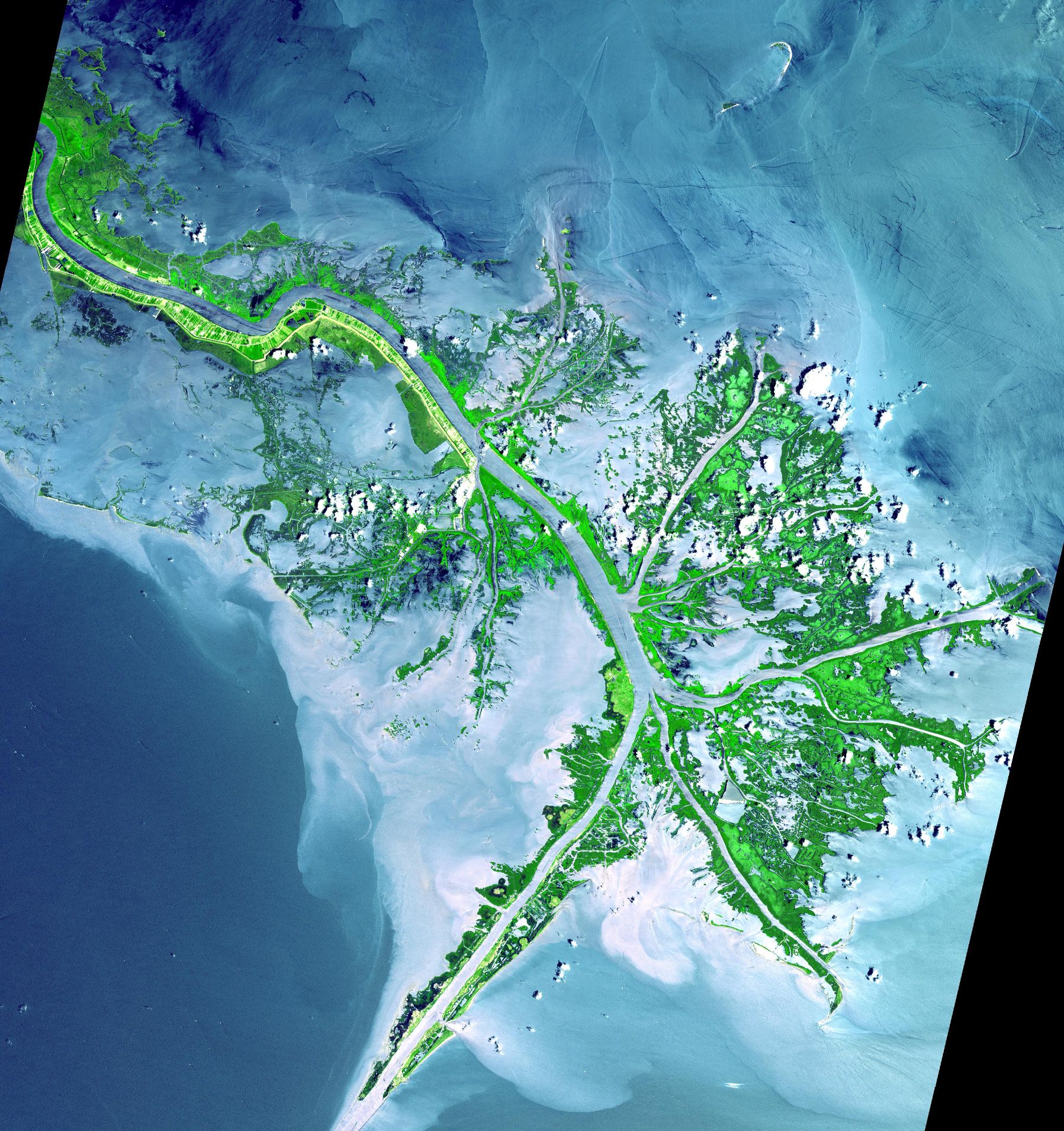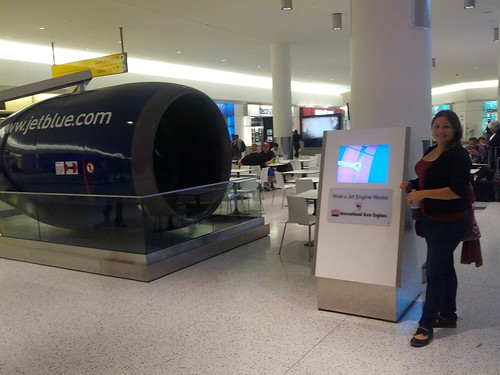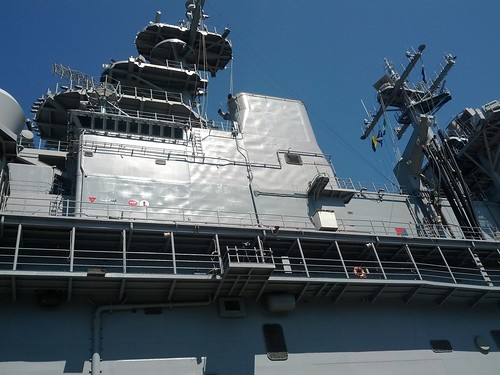UPDATE 2- I'll just add the recent Bob Marshall Op-Ed about updating the bird's foot to save the coast and help the port here. Worth a read.
Saturday, December 29, 2012
Gating the Rigolets?
UPDATE 2- I'll just add the recent Bob Marshall Op-Ed about updating the bird's foot to save the coast and help the port here. Worth a read.
Friday, December 28, 2012
Contagion

Nipah virus is an active virus. It's had multiple outbreaks, some with dozens of fatalities (very high mortality rate; easily communicable), and there's still no vaccine or cure today. And it's still out there today.
Discussion of Contagion by epidemiologists
What's interesting about epidemiology is it's a never ending battle. You have to constantly be on your toes, because viruses mutate over time.
One of my favorite parts was where one of the scientists working on the cure talked about Dr. Barry Marshall, who drank an infectious broth to prove his theory was correct. That's a pretty amazing way to put your money where your mouth is.
Check out the movie. Also take a look at John Barry, author of Rising Tide and The Great Influenza, writes about what's next for Swine Flu. The Great Influenza is also worth a read.
Saturday, December 22, 2012
Tuesday, December 18, 2012
41-0
Saturday, September 22, 2012
Rising Tide 7

* The "Petri Dish" metaphor is good and applicable to both the journalism and education 'reform' initiatives. Good job whoever came up with that one.
* Very good steering of panels. Panel discussions were well directed and no eyes were gouged or blood was drawn.
* Great job getting more coffee early this morning. It was sorely needed after the previous night.
* IMHO, the weakest panel was "Oil and Water". Not a lot of new ground covered. It could have been better and I think the parenting panel drew a lot larger crowd than they were expecting. Also should have set out to at least discuss Bayou Corne (w/o the audience asking a question).
* Karnofsky and Louis Armstrong: http://t.co/jc6pdFNB
* Tulane got their butt kicked by Ole Miss http://t.co/hD5aKELV
* Here's Bob Marshall's Op-Ed about subsidence from earlier this week: http://t.co/zpfF0fuh
* Another bid issue nobody brought up is the complex litigation related to Macondo is actually limiting how much research gets published. See here for a sample: http://t.co/G0Elc2m3
* Not mis-allocating the BP Spill money was mentioned as an afterthought. We could have spent a panel on just that.
* Cenlamar has #standing, even when #seated.
* All this discussion about the Times-Pic is like a funeral. I'd rather spend a little more time chatting about what The Advocate is doing. Also, the only one with any energy is Jason, who's been up since dawn setting up and managing the webstream for Rising Tide 7.
* Nola.com writeup of the Education Panel.
Thursday, August 30, 2012
Storm Surge & Pumps & Albert Baldwin Wood
One thing I learned as an engineer while working for a large hot sauce concern in South Louisiana is how subjective runoff calculations are. You can have 2 systems that are rated for the same 10-year rain event, but are dramatically different. You start by assuming how much retention the land has at the start of your design-case rain (saturated soils absorb ~nil). They you have retention ponds built (which will actually fill up over time). Only then do you size the pumps. A modern drainage system tends to be very dependent on retention ponds (like New Orleans East). The system that Albert Baldwin Wood designed in the 1910's is almost exclusively pumping power. As designed, there was virtually no retention capacity built into the system. Over time, the S&WB has added some retention capacity in; for example, before a storm, the canal water levels (which have a certain, nominal level, just for the stability of the canal banks) are drawn down as low as possible. There are also relatively few, much larger pumping stations in Albert Baldwin Wood's design. The downside of this is the feeder canals are much longer and deeper, so when there's a problem, the S&WB has to dig to China to make a repair. On the bright side, it means that it's easier to keep power supplied to fewer stations; Jefferson Parish has something like three times the number of lift stations as Orleans Parish*. Wood's system was a bit more expensive to construct and maintain, but a modern system basically raises a white flag after a certain amount of time (when the retention ponds are full), while Wood's system can keep chugging right along hour after hour with minimal de-rating.

Photo of pumps being pulled from a few months back.
___________________
* Source: A Goulds pump salesman told me that.
NOTE: Some edits for spelling.
Wednesday, August 29, 2012
Still here...
Monday, August 27, 2012
Isaac
Stay safe.
Also, here's my suggestion for a really handy piece of hurricane gear:
http://www.amazon.com/Motorola-Universal-Dual-Charging-Portable-Power/dp/B00486MH80
It keeps your cell phones topped up. It has ~80% of the charge of my Samsung stored for emergencies.
Sunday, August 26, 2012
One Small Step...
Head of Passes
I want to tie a few different threads together here. We have the release of Louisiana's 2012 Coastal Master Plan (Large PDF), the expansion of the Panama Canal, the struggles of the Port of New Orleans during low water levels, the BP spill fines, and Louisiana politics.
Mississippi River levels are now so low, barges are grounding (note: this article talks about barges upriver of Baton Rouge). You can notice all sorts of other signs: if you drive across the CCC bridge, you'll notice extra barges around Algiers Point for lightening the load of freighters coming up the river. If you taste the tap water right now, they're putting extra chlorine to combat the low levels. These ultra-low levels happen about once ever 10 years and they are a pain for the Port of New Orleans. The fall, for whatever reason, tends to be the busiest time of year. That's also when river levels are the lowest. Meanwhile, Congress funds the Corps' dredging and asks them to meet 40' depth (which they almost never reach, due to lack of funds). They allocate ~$500 million dredging (don't worry too much about cost; it more than pays for itself in commercial activity). The Port kicks in some extra, but in times like this, they always end up ~$50-100 million short of what they really should have to keep the port completely busy. The other thing is much of that dredging money isn't spent on Southwest Pass (photo below), but instead at Pass a Loutre (a smaller, shallower channel, that, if you ever did a proper economic analysis, it'd say 'dredge more at SW Pass).
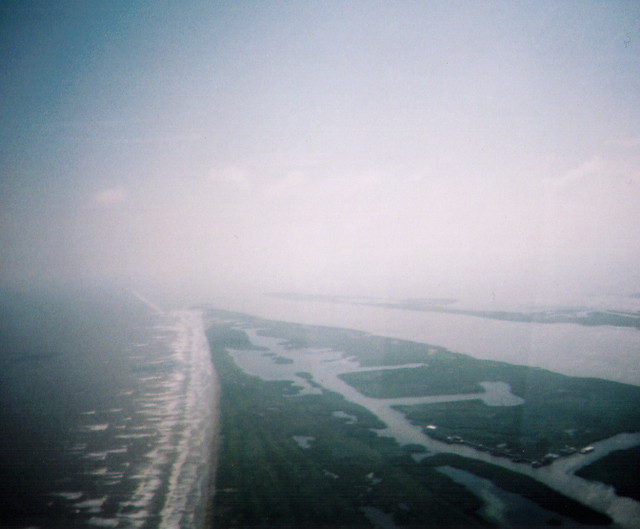
The capacity of the Panama Canal will double when the expansion project is complete. Sometime in 2014 (or shortly after), ports that want to recieve traffic will need channels at least 50' deep. After being caught up in Tea Party politics for years (note: dead link), Florida is finally pushing forward with the Deep Dredge project. The Port of New Orleans had a great opportunity to leapfrog Miami and now their window of opportunity may be closing. Meanwhile, Boss Hogg's plan to renovate Gulfport into a Superport has fallen apart (note: dead link). Fortunately, Slabbed has been on the case.
It would be great to kill 3 birds with one stone: restore the coast, promote shipping, and protect New Orleans from hurricanes. There's coalescing around a plan to abandon the lower Bird's Foot, divert the river, and also have a newer, shorter route to the sea for shipping. Dr. Renfro's got an article along those lines here (also, congrats on finishing the PhD; I saw her present at a past TEF as just a PhD student). The diversions will also continue to work, even without constant infusions of major cash (unlike dredging). So, that's what we NEED to be doing. What are we doing instead?
Well, first, we're fighting over the BP spill money. There's also a fight to chip away at the few wetland protection laws there are. Louisiana Legislators want to raid the BP money for use on their own pet projects instead of spending it on coastal projects. Fortunately, we seem to be doing OK at beating that idea back.
Fishers and dredgers oppose Coastal Master Plan. Unfortunately, I see a drift away from the "Engineered Avulsion" idea and towards dredged sediment restoration. What's so bad about dredged sediment diversion? Well, first off, what is it? It's when you dredge a bunch of sediment, put it in a particular place, and it promotes further land growth. Here's an example:
So, we have a fight between doing what's needed to save the state from sliding into the ocean (and making the Port of New Orleans a Superport) or in the short-term putting a few nickels in a politically-connected pocket and continuing with business as usual. Which way will it go?
UPDATE- gCaptain article about keeping the MS River dredged.
MegaStructures: Independence Hub
When Independence Hub came on line, domestic gas production increased by >10% with a single facility.
Saturday, August 25, 2012
A Hole in the Bottom of the Bayou
LA-DNR Sketch of Texas Brine cavern.
Plan view of nearby areas of interest - via LEAN.
One of the safety systems usually installed in these storage caverns is one ore more relief wells, pre-drilled. These relief wells don't serve the same function as the Macondo relief well did (pump mud/cement down to stop the problem). The relief well(s) are there to draw down the well as quickly as possible (generally going straight to a flare stack, burning up all the valuable product; imagine emptying a bank vault by setting the cash on fire). The goal is a controlled release instead of a uncontrolled relief.
Note that the relief well just had to stop drilling in order to case the well.
* ABC's of the Sinkhole
There are almost always historical parrallels for engineering disasters. Here's a few off the top of my head:
UPDATE- Minor formatting glitches fixed.
Political Attack Ads...
Wednesday, August 8, 2012
Corps-Created Sill Gives NOLA Fresh Water
UPDATE: Mike Schleifstein Writeup
Sunday, August 5, 2012
Indicates that just because customer doesn't like the answer, the laws of physics must prevail.
H/T Tim.
Monday, July 30, 2012
"Rust Never Sleeps"
It slowly eats away at steel night and day; See about the rusty pumps for one example.
Saturday, July 28, 2012
A Hole in the Bottom of the Sea
A Hole at the Bottom of the Sea: The Race to Stop the BP Oil Gusher

A Hole in the Bottom of the Sea focuses on the post-blowout oil spill response (capping, top kill, top hat, etc.). In Fire on the Horizon, the rig didn't blow until page 200 or so. In this book, the rig blows up on page 30 and the well intervention lasts past page 200.
The writer has a background as a science writer for National Geographic. On the plus side, that means he has a firm understanding of things like measurement uncertainty, error bars, etc. On the downside, he has no technical background so there are some errors that are pretty blatant (for instance, he confuses erosion and corrosion, two completely different processes) that still make it into this edition.
Note that I picked up the post-Fukushima paperback copy. This book has been through at least 3 editions, from what I gather. That probably fixed a lot of earlier errors.
The writer has one soapboxy-bit: 'We now live in an engineered world and we'd better accept it.' Achenbach also probably managed to have carnal knowledge of his thesaurus as he wrote this book.
If you're interested in the well intervention (and only the well intervention) this is a great book, but the definitive Deepwater Horizon book has yet to be written. I'm waiting on David Hammer to write it...
Also-
Grover sings "A Hole in the Bottom of the Sea"
Weight managment is especially key on thing where weight-performance tradeoffs are key (like cars, planes, rockets).
On the problems with 'fast-tracking' projects. See also: The Mythical Man-Month.
Wednesday, July 25, 2012
Engineering Sayings:2
Engineering and especially project management is often the art of compromise. You'll almost always be short on something/pressed on something. A good engineer doesn't give up or put out a crap product, but he will, for instance exceed his budget when crunched of schedule.
Engineering Sayings: 1
"Belts and Suspenders"
Multiple, redundant safety systems. Also sometimes overkill.
Ex.- How can you pick a conservative engineer out of a crowd? He wears both a belt and suspenders to keep his pants from falling off.
Monday, July 23, 2012
Piper Alpha: The worst disaster in the history of offshore
Many years before Macondo, there was a much more deadly disaster offshore in the North Sea.
Piper Alpha was the largest platform (by production) in the world in its era (317,000 barrels/day, peak). It was built in the North Sea by a consortium run by Occidental and Dr. Armand Hammer.
I recently picked up Fire in the Night: The Piper Alpha Disaster by Stephen McGinty. The book was only published in 2008 (the incident happened in 1988), so enough time has passed to be able to sort things out.

In addition to time, the Piper Alpha incident had the benefit of the Cullen Report (summarized here), which is a Royal Inquiry. In the US, we have this pesky thing called the 5th Amendment, which protects people from self-incrimination. Under a Royal Commission, they just do away with that. Someone doesn't want to talk, they just lock them up until they feel like spilling the beans. Lord Cullen never had to actually do that to anyone, but I'm sure having a bazooka in your pocket, as Secretary Paulson once said, doesn't hurt.
There were many, many lessons learned from Piper Alpha that are now standard on offshore operations today (SSIV's, Temporary Safe Refuges, etc.). One of my favorites is intumescent paint:
It expands, forming an insulating layer that keeps major structural items intact long enough for an evacuation. In Macondo, 10 people on the drill floor died basically instantaneously. Only 1 person died after the initial explosion (a crane operator who fell and was incapacitated and later burned). All others were able to make it to a safe refuge and the Deepwater Horizon stayed structurally intact for quite some time (~36 hours!). There's actually some disagreement out there as to whether it was the fire that finally killed the rig (high temperature weakening of steel), or the haphazard firefighting dousing the wrong areas in water and flooding the hull (ballasting down the ship, causing it to capsize).
One sad parallel between Macondo and Piper Alpha was the confusion that all too often accompanies disaster. In Piper Alpha, loved ones waited at a hospital in Scotland. One by one, helicopters would land and there would be those who would find out their loved ones made it. Eventually, there were no more helicopters and the families were notified that's all the survivors. Sadly, for another two days, some clung to a rumor that a 'Russian freighter' had picked up most of the rest of the crew and was steaming to a port with the radio broken. Some of the families even drove up to the port to wait on a freighter that would never arrive.
In Macondo, noted fuckface Jiff Hingle, Sheriff of Plaquimines Parish* spread a rumor that a survival capsule was found and contained all of the 11 missing. MSNBC** and Fox News reported that as fact. One of the widows was actually on the phone with her husband's employer getting the news her husband would never return when she saw on the news the report and went on and on about how "he's alive" while the TO employee was patiently trying to explain that the report was false and he died on the rig. Also, both the UK, under a Socialist Prime Minister, and the circa-2010 MMS had almost exactly the same Inspector:Platform ratio.
In the Piper Alpha disaster, Fast Rescue Crafts were worth their weight in Myrrh. My favorite part of the whole book was the story of the Silver Pit's FRB. It pulled more people out of the water than anyone else. It made several 'easy' rescues early, but then took an absolute beating later on when it edged in near the inferno to pick up survivors. They have a load of 3 survivors on board, 4 crewman on the boat, including the coxswain. The boat is leaking and the motor is starting to sound like it's on its last legs. The coxswain spots someone directly under the inferno waving for help. The platform was collapsing into the sea and just the heat flux from the fire that close would give you bad burns, but the Coxswain asked his boatmates, "...Are we going to go? We're his only hope."
The response was a chorus of "GO!" The coxswain puts the throttle down, they go in full speed and with no margin for a second run or even slowing down (with the inferno over their head and the platform literally coming down in pieces all around them) and the crew grabs the swimmer out the water and pulls him in to safety. He survived, despite bad burns.
The FRB goes back to its mothership, offloads survivors, then despite massive damage, wonky engines, and the boat sinking underneath them, it goes back out to try to rescue more. The FRB was all used up from their antics and sank beneath their feet. The coxswain bobbed in the North Atlantic satisfied he had done absolutely everything possible to save people. The final death toll was 167 with only 61 survivors. 33 were rescued by the Silver Pit's FRB.
There is one direct link between Macondo and Piper Alpha: The Tharos / Deepwater Marianas. The Tharos was a dive support vessel that someone billed as an 'offshore fire engine' on the side. It had some design defects and didn't save as many lives on Piper Alpha as it probably should have. It later got converted to a MODU. That MODU spudded (started the drilling) of Macondo. It on the scene for both Piper Alpha and Macondo.
________________
* Source: "A Hole in the Bottom of the Sea" by Joel Achenbach, page 44
** Source: "Fire on the Horizon"
Saturday, July 14, 2012
High School Reunion
So, I just found out at the very last second my high school reunion was tonight and did manage to catch up with a few people.
For those of you checking in, here's Ms. White's homeroom class from freshman year. Found a print of this going through some old boxes a while back. Sorry about the scan quality.
Saturday, July 7, 2012
Polonium: The best and worst poison
So, while up in New York, I picked up The Poisoner's Handbook from The Strand. The subtitle is 'Murder and the Birth of Forensic Medicine in Jazz Age New York'. I loved it. It's a murder mystery with heavy doses of history, politics, and science. I'll give it one of the best compliments I can give a book: it reminded me of Rising Tide (one of my favorite books of all time).
Poisoning has always sort of been a "coward's weapon" (killing in secret without the chance of glory, like open battle). The 'Hassassins' terrorized the Middle East, until their downfall in the 14th Century. Poisoning has slowly been dying off due to advances in medicine and science. Doctors can cure a myriad of poisons and forensic scientists can extract tell-tale clues of poisoning, leaving the assassin (and those that order the hit) vulnerable to retaliation.
Except for 1 obscure poison: Polonium. It looks to be more in use than we realize. There's the famous Litvinenko poisoning case in 2006, but it looks like there is at least one more from 2004:
Excellent report about the possible (probable?) use of polonium to assassinate a head of state. I definitely recommend the second half of the video where they go through how they investigated. Great work.
Why is polonium such a great poison? Well, for background, I'll highlight the brain teaser about the 4 radioactive cookies. Polonium is an alpha-emitter. You can hold it in your hand and be perfectly safe. You can have a vial of water with enough polonium to kill dozens and have it just sit there and it won't be easily detected and won't harm a potential assassin, but you sprinkle it in, say, the target's tea or on the target's sushi and they ingest it, they'll die a slow, painful death over 3 weeks and doctor's won't be able to figure it out or cure it...
...Except if you have a radiochemist specifically looking for polonium. Then, even sub-milligram quantities of polonium can be revealed and analyzed. You see, during the early stages of the Manhattan Project, scientists knew plutonium could also be useful to make a bomb and would be much easier to manufacture than Uranium-235.
Years before, chemists had developed a branch of analysis called microchemistry which could handle tiny amounts of chemicals weighing as little as 0.001 gram. But not even such a tiny bit of plutonium was available. So the chemists at the University of Chicago under Glenn Seaborg began in April, 1942, to develop a new method which could handle chemicals which weighed no more than 500 micrograms (1 microgram equals one-millionth of a gram) or about 1/5000 the weight of a single dime. ... This method is known as ultra-microchemistry.
From the data Seabourg's team extracted, engineers were able to then refine designs of nuclear reactors and bomb components months before usable quantities (kilograms) of plutonium were available.
Moving from plutonium to back to polonium, very small amounts of polonium can be extracted very far after the subject is poisoned. It's like a heavy metal; it persists and doesn't break down. It will radioactively decay, but you can still track the 'daughter-products' and that breakdown allows you to even track when the polonium was created. With a large enough sample, from tracking the isotopes of the polonium, a good radiochemist can even tell you which reactor made the polonium. All of these factors make it a very BAD poison to choose.
Wednesday, July 4, 2012
"Longest Time" Biology Music Video
Via Boing Boing
The part with the skittles is a particularly good, yet simple demonstration of evolution.
Monday, July 2, 2012
Sunday, July 1, 2012
The 125-Year Old Brooklyn Bridge
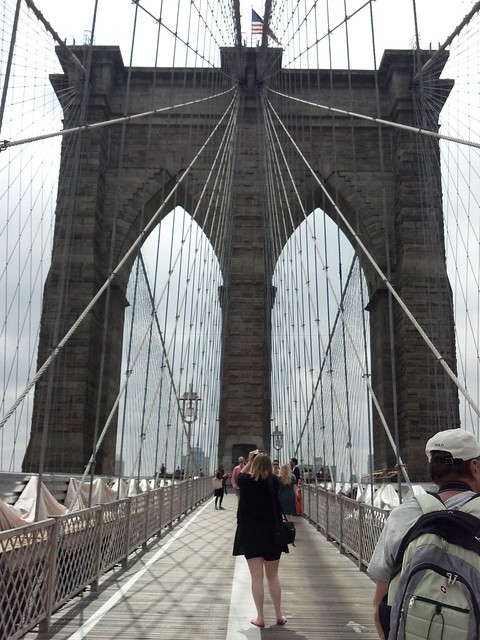

Built by Washington Roebling, with help from his father and his wife Emily, the Brooklyn Bridge is a milestone in the history of civil engineering. It's also a damn pretty bridge. My wife and I took a bunch of photos as we crossed over the bridge on foot.

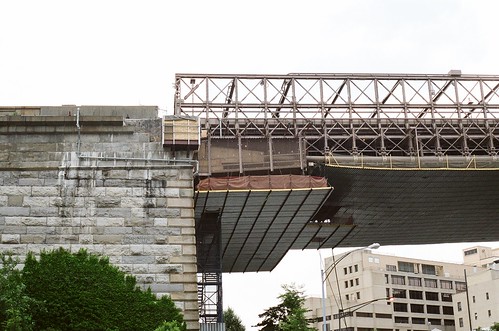
This photo above is actually the buttress where the cable holding the bridge up is tied into basically a giant weight.
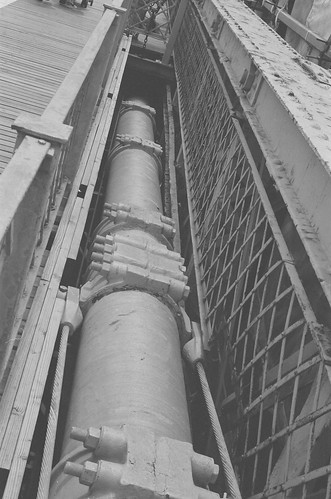
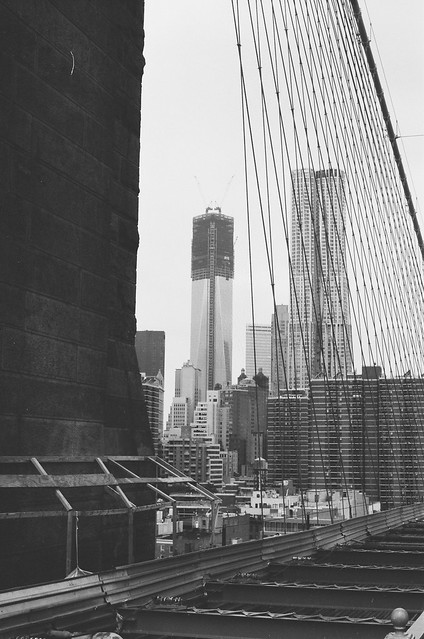
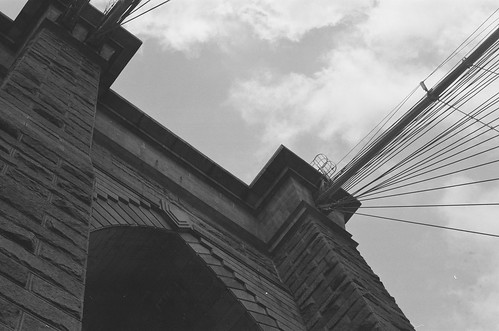
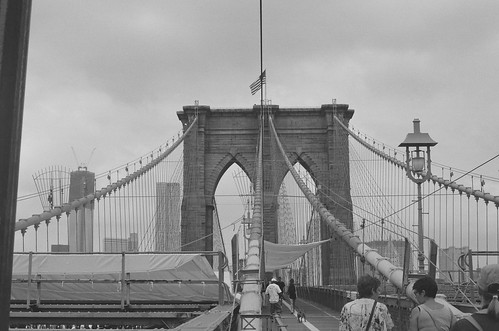


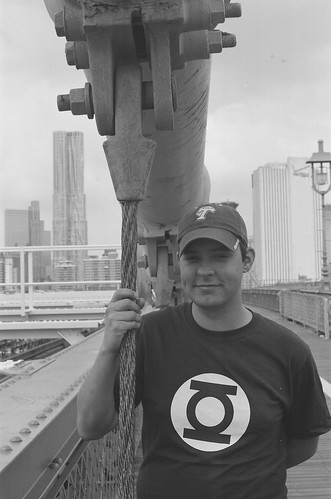
After this, we also got some awesome pizza under the bridge.
Book Review: "Fire on the Horizon"
It's about 2 years since everyone was glued to their TV's watching ROV's try and plug a hole in the bottom of the sea. Since then, numerous books have been published chronicling the explosion and the spill. Here are just a few writups of the multitude of books:
9 Books - LA Times
Publishers have no shortage of books - NY Times
In Book Form - MoJo
Each book focuses on a slightly different aspect of the disaster. After reading a few reviews, I chose Fire On The Horizon: The Untold Story Of The Gulf Oil Disaster by John Konrad and Tom Schroder.

Konrad holds an Unlimited Master's licence and has worked for many years on oil rigs. In his off time, he started a Maritime site called GCaptain. It's actually how I first heard about the Deepwater Horizon fire (one of the reasons I picked the book; they beat everyone else to the punch).
The book gives excellent background to the leadup to the disaster. I particularly enjoyed the chapter on the rig's construction in a South Korean shipyard. The maritime background of Konrad helps out a lot. The book nails the maritime aspects of the disaster. Konrad also knew some of the members of the crew, since he worked for Transocean for a time and graduated CUNY Maritime at about the same time as some of the maritime crew.
The cultural aspects of life onboard a rig, while probably not telling 100% true stories, does convey the culture pretty well. They do a good job in humanizing the crew of the rig.
I have two big criticisms of the book. First, the book is overly kind to the boots on the ground. Normally, I'd agree, but I'm not quite sure in this case. I think there is some blame that deserves to say with the field team. The book also really lets Captain Kutcha off light (although I believe Konrad was friends with Ktucha, so there's one explanation). The other criticism is when they get to the complicated petroleum engineering of the actual well construction, it's just a poorly written summary of David Hammer's writing. They lean on the Picayune's writing without giving anything new nor do they even properly summarize it. It takes them more than half of the book to even get to the drilling operations. Pages 128-130 really needs some editing because it's clunky and if I didn't know exactly what they were trying to explain before I read a sentence, I'd be lost. That was pretty disappointing. I'll hunt for another book to compliment that part.* There's also very little coverage of the oil spill (the first half is background, then 1/3 is the actual Macondo well and fire, then the balance is aftermath, spill, widows, etc.).
There's also one thing that I knew about, but didn't realize. What did the Titanic and the Deepwater Horizon have in common? Not enough lifeboat space. A major problem with current lifeboat standards is IMO rules on dictate lifeboat design based off "50th-percentile" standards. In other words, the lifeboat design is only meant to accommodate the average member of the public (~160 lbs.), not the average rig hand. On a Gulf of Mexico rig, almost everyone weighs at least 180 lbs. and there's guaranteed to be at least a few 280-300 lbs workers. The Deepwater Horizon only tested its full lifeboat capacity once in Korea, and that was with 110-lb. Koreans. Once in the Gulf of Mexico, given the larger crew, the Deepwater Horizon couldn't actually conduct a full evacuation without resorting to the use of inflatable rafts. If you also had any seriously injured personnel on a stretcher, you'd lose another 6 seats per stretcher on top of that!
This isn't something new. I heard about this years ago. Here's an International Association of Drilling Contractors (IADC) notice from before the Deepwater Horizon incident:
Anthropomorphic compatibility. Most SOLAS-approved lifeboats have been approved on the basis of an assumed occupant mass of 75 kg (≈ 165 lb). The IMO has recently revised its requirements to increase the assumed occupant mass for lifeboats on most new installations to 82.5 kg (≈ 182 lb). IMO did not alter the associated seat width standard, which remains 430 mm (≈ 17 in), when increasing the assumed occupant mass to 82.5 kg. A so-called “Gulf of Mexico standard” is being used by some that assumes an occupant weight of 210 lbs (≈ 95 kg) with a corresponding seat width of 21 in (≈ 530 mm). This matter is also being addressed by coastal State authorities in the North Sea.
Every project I've worked on has used 220-240 lbs. as an average weight. A company I work for actually did a survey of their employees entitled "How Big is Bubba's Butt" that was the source of the higher figure. It's also common to leave room for one stretcher without compromising seating capacity. Also, davit-launched inflatable liferafts are unreasonably complicated to use in an emergency situation.
Every large Gulf of Mexico installation should be audited to ensure that they can actually conduct an evacuation in a realistic manner. Tests should be robust (a sign of a nice and rigorous test is failure, like this one). Not leaving enough margin for actual crew weight or overly complicated launching isn't sufficient.
_____________
* Debating between Bob Cavnar's book and Achenbach's book. Anyone read either?
Tuesday, June 19, 2012
how a jet engine works
You know what, flying should be fun. You're riding in air at hundreds of miles an hour, traveling across the country. That's something worth celebrating and treating like it's something special instead of something miserable that you have to endure like a colonoscopy. Jet Blue really tends to put the fun back into flying. They had this setup on "how an engine works" and it made my inner engineer glow with joy to see little kids walk up to the button (which is located within easy reach of a 7-year-old). The presentation was pretty good too (although they left out 'suck, squeeze, bang, blow').
Seems like a small thing, but it made me happy to see. Turbomachinery is really amazing and the US is the undisputed leader in jet engines. Only Rolls Royce can even pretend to be in the same league. One funny little detail: Honda's engineers INSISTED to the Board that they start an aircraft division; the engineers insisted to the board it would help them recruit engineers. The board complied and Honda probably loses money on their aircraft, but it keeps the engineers happy and you have to admit Honda makes some very well designed cars across a broad range of price points.
Sunday, June 3, 2012
Sunday, May 20, 2012
Creationist Louisiana State Senators
Fools on Parade. Indeed.
Once upon a time, people actually had some shame. First off, there's THIS, which I'm not even sure how to process, then there's this video of Julie Quinn making a complete ass of herself.
"I am an attorney and I would like an answer!" - Julie Quinn, lawyer and moron. Speaking of lawyers, I wonder how Quinn, as a lawyer and a one of those entrusted to oversee taxpayer dollars, would comment on how Kitzmiller v. Dover Area School District was a good use of taxpayer funds, because it's only a matter of time before Louisiana gets its ass sued off. More here.
"People with little letters behind their name" include doctors, engineers, and scientists. But, Julie Quinn is a lawyer, so it's all good. She can fix our levees, design deepwater oil platforms, heal the sick, discover cures to diseases, invent new things, ... Oh wait, no she can't actually do anything; she's a lawyer. If one useless man is called a disgrace, what are two useless men called? A law firm.
Kudos to Karen Carter Peterson (the new head of the burnt-out cinder of what used to be the Louisiana Democratic Party).
Unfortunately, KCP is outnumbered by the asshats. See the sad evidence below.
Here's Zack's take:
Note that the push to repeal LSEA failed.
Book Review: "In Mortal Hands"
In Mortal Hands: A Cautionary History of the Nuclear Age
I firmly believe that all practicing engineers should read at least one 'engineering disaster' book a year. It's been a little while for me.
The first ~100 pages are not worth reading. It's a poor synopsis of Richard Rhodes and I liked the original better. You need to skip to about the 1970's before the book gets worthwhile (although the Israeli bomb chapter is excellent).
The author was a journalist covering the nuke industry and once she gets closer to what she directly covered in her interviews with first-hand witnesses, the book improves dramatically. The best parts is her coverage of the regulation of the civilian nuclear industry. For example, Victor Stello over-protected the industry (to its detriment), while others at the NRC did their jobs.
Some of my other favorite stories:
* The (sad) story of a Chernobyl firefighter and his pregnant wife.
* The cataloging of the costs of failed experiments in reprocessing and breeder reactors.
* The story of Remy Carle at his graduation from Ecole Polytechnique.
* Western nations really only care about nuclear proliferation when it's convenient (and because of that, have, in the past, helped out 'rogue' states like North Korea and Iran much more than they'd like to admit). For instance, the United States KNEW Saddam was using a $500 million agricultural loan to fund his bomb program, but, despite please from those overseeing the program, continued funding it (not necessarily out of nefarious intentions, probably just bureaucratic laziness).
Overall, I got what I was looking for out of it. Even the book's biggest flaw (the beginning) is not much of a flaw, because I'm comparing it to a Pulitzer Prize winning book.
UPDATE- One of the stories from the book is MOSSAD's theft of uranium from Pennsylvania. Apparently, that story can now pretty definitively be but in the "True" column.
Saturday, May 19, 2012
Darwin the Dinosaur impresses
Note that the group is from New Orleans and based out of the CAC. Their website is here.
It takes some balls to be pro-Darwin in a state wheredangerous fools like this have power.
More dancing here:
Friday, May 11, 2012
Engineering Links of the Afternoon
* PHD: Graduate School Enrollment vs. Unemployment Rate (graduate enrollment in engineering).
* Some Important Things Most Students Never Ask About Graduate School [PDF]
* Going to grad school while working. Great quote: "No Matter How Much You Love Your Job, You Will Love Grad School More". Actually, this one is turning out pretty true. Also: #1 Drawback: Time
* A history of offshore drilling. Excellent white paper on the history of the offshore business.
* The cost of new oil supply. The chart for the cost/well is amazing.
* Liberating America's Secret Laws. Overly dramatic title, but interesting subject, because things like ASME's Boiler Code are a part of the law, but not actually accessible to common citizens.
* Ignition! The history of the development of rocket fuel.
Saturday, April 28, 2012
Major plate distortion
While waiting in line I took this photo of the superstructure of the USS Wasp. Note the 'wrinkled' appearance of the plate. One might ask how is extremely strong plate wrinkled? Here's a hint: that didn't happen from wear and tear; the USS Wasp left the shipyard looking like that.
In the old days of battleships, the Navy never had this problem. 12" of battleship armor doesn't like deforming. Now, the Navy has shifted to using very thin, very strong steels. 90% of plate steel used in modern Navy shipyards is 10mm thick or less. The plate is extremely strong; old steel might only be 30-ksi, while modern steels (like HSLA) are 100-ksi. The Navy has been using these high yield steels since the early Nimitz-class carriers.
How can you work these high strength steels into the curves and complex geometry of a ship? Well, not with bending. They are too strong and you'll either need too much force or you'll deform the steel. On the other hand, if you use the steel's own properties against itself, you can easily deform it. All materials are subject to thermal expansion. If you heat up the steel enough in just the right way, you can induce the curves that are present in the hull of a ship.
Why is the photo wrinkled? Well, how do you put a modern naval ship together: Welding, a thermal process. The deformation is from welding. The Navy has also been tearing their hair out trying to resolve these wrinkles for the past 20 years. There are all sorts of reasons the Navy is concerned, but one big one is radar signature. The curves reflect radar waves extremely well and make the Wasp look like, well, an aircraft carrier on radar. It makes it extremely easy for an Exocet to home in...
Solving this problem is a hot research area. UNO happens to be at the forefront of a lot of this research.
Sunday, April 22, 2012
A Naval Architect goes to NOLA Navy Week
I had a little detail I wanted to point out that I noticed in Navy Week.
First off, what is Naval Architecture? Well, ABET recognizes 3 very closely-related disciplines: Naval Architecture, Marine Engineering, and Ocean Engineering. Naval Architecture generally concerns hull forms, Marine Engineering usually concerns engines, propulsion, and ship systems, and Ocean Engineering is sort of civil and mechanical at sea. Here's a nice little paper describing more along these lines.
So, one of the things I noticed this weekend was the differences in hull geometry between the 3 vessels at the Governor Nicholls Wharf. In the photo below, the USS Mitscher is first, followed by the USS DeWert, with the French Frigate Germinal last:

The DeWert is the oldest design of the three. It's an Oliver Hazard Perry-class frigate. It has a hull geometry that was very similar to WWII-era designs. As a result, its sea-keeping abilities leave something to be desired. Here are some photos of a Knox-class frigate, the OHP-class predecessor, trying to cope with 45'+ waves. "Green water over the bow" is when you start to really get worried. Here are some even more amazing photos of similar-sized military ships coping with big waves.
I got to talking with a seaman on the DeWert and he wished the ship had a wider beam. There are three stages of sea-sickness: seasick, so seasick you're afraid you're going to die, and so seasick you're afraid you AREN'T going to die and it will never end. You could tell he'd been the third category of seasick at some point in his naval career.
The other two vessels are much more modern and had some interesting design characteristics to cope with heavy seas.
The FS Germinal had a double-decked bow. More photos here.
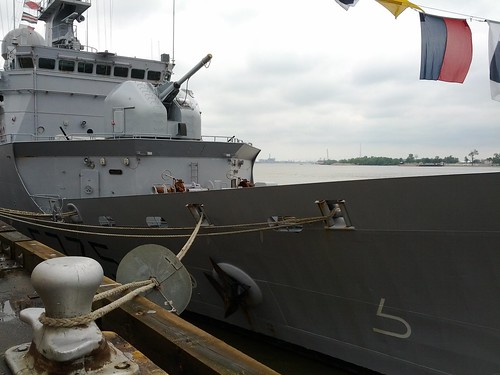

The lower deck held the anchor-handling gear (windlass, etc.) and the upper deck held the armament (something you really don't want getting wet). The lower deck you can tell is regularly awash, due to the extensive corrosion. The advantage is there's less of the bow to get sucked-under when it does go awash and the upper deck stays much dryer. The disadvantage is the lower deck is regularly awash and I'd be willing to guess the design is a bit heavier.
The Mitscher is the largest of the three vessels, but not by that much. From talking with the destroyer's crew, it is a very, very seaworthy vessel. One of the main reasons is the intricate chine on the bow:
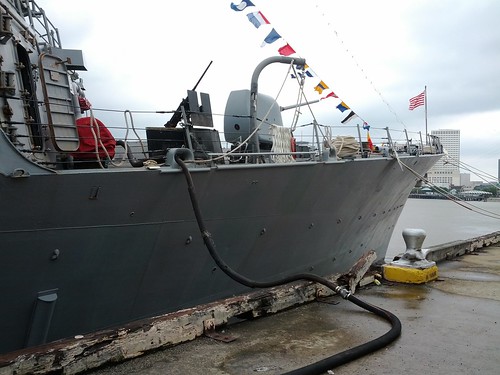
It was the result of a lot of studies of behavior of especially OHP-class ships in the North Atlantic. The design keeps the deck relatively dry by allowing just enough movement, but not so much that either the crew get seasick or the sonar-dome goes out of the water.
So, if you're a Naval Architect, these are the sorts of decisions that you need to make. The net result of all the decisions and compromises results in the final design of the ship.
NOTE- Some updates after publishing

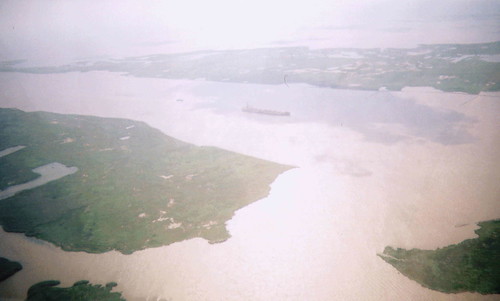



.jpg)




